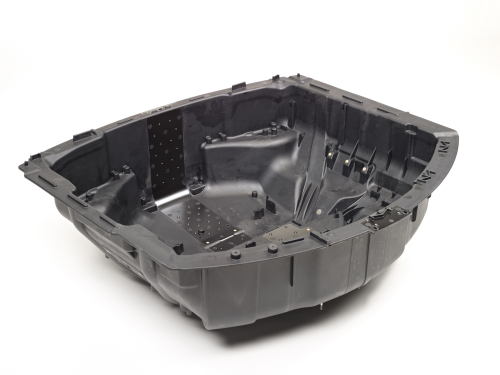
The spare wheel recess is made using Durethan DP BKV 60 H2.0 EF, a 60% glass fibre reinforced PA 6 from German speciality chemicals company LANXESS. The part is 100 cm x 85 cm x 32 cm in size and is manufactured by Dutch company Vestalpine Plastics Solutions of Putte, the Netherlands, using an injection moulding process.
“Our polyamide 6 is the material of choice because it enables precise injection moulding of the part’s complex geometry,” states Martin Klocke, Key Account Manager for Audi. “It would be very difficult to make the component from sheet metal due to the limited space available and the high draw ratios.”
“Our plastic also enables direct integration of numerous functions,” he explains. “Incorporating these functions in a metal design would have required a large number of separate production and assembly steps with all the associated costs.”
One of the reasons for deciding against a glass mat reinforced thermoplastic (GMT) design was the huge amount of reworking the finely structured component would have required.
The component is bonded and bolted to the body framework and fulfils the additional function of reinforcing the rear end of the car. This is achieved by integrating two reinforcing channels, each around 2 m long, using gas injection technology (GIT).
The PA 6 makes a major contribution to the high overall stiffness, reports LANXESS. Its tensile modulus of approximately 19 000 MPa at ambient temperature is twice that of a standard 30% glass fibre reinforced PA 6. It also retains its stiffness at high temperatures – as required by Audi for components located close to the exhaust system.
Stiffness and strength are also important because the recess supports numerous fittings and attachments weighing a total of around 70 kg, including the spare wheel, vehicle jack, tools, battery and various control units. The battery is attached to an aluminium sheet that is integrated in the component; this stops it from becoming detached in the event of a rear-end collision.
The spare wheel recess is made in a single-stage injection-moulding process. Particular challenges include the size and complexity of the moulded part, the high shot weight of around 12 kg, precise back-injection of the aluminium sheet for the battery, and integration of the GIT process for the reinforcing channels. Precise metering is achieved using a 2700 tonne moulding machine with a screw that has a relatively large diameter of 150 mm.
First of all, the PA 6 is injected into the mould. The material’s excellent flowability – similar to that of a standard PA 6 with 30% glass fibres – means that only two gates are required. The GIT process is then used to produce the reinforcing channels, the excess melt being forced into overflow cavities.
“Our material makes thin walls possible,” explains Markus Hildebrandt, a GIT expert at LANXESS. “What’s more, the expelled melt can be returned to the process as a recyclate at a ratio of 30%.” Because of its excellent flowability, the LANXESS highly filled PA 6 is reported to result in mould wear comparable to that observed when using a standard PA 6 with 30% glass fibres.
LANXESS provided a range of services during the development of the spare wheel recess. This included using mould flow analyses to optimise wall thicknesses and minimise distortion, and help with mould construction, mould proving and initial production trials. It also tested the GIT material’s recyclability and used integrative simulation to calculate the moulded part’s vibration characteristics.



